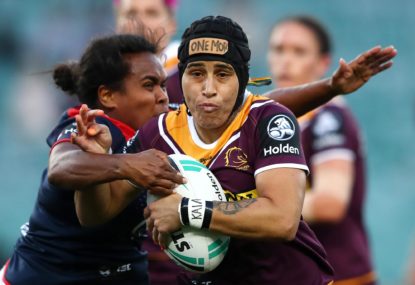'I was attracted to the danger': James Graham strongly defends kickoffs amid safety debate
With several players knocked out this season, evidence is mounting to scrap or shorten kickoffs - but Graham questions whether the concern is all…
Opinion

Given the focus by some mainstream media organisations on ‘predicted team lists’ for Round 1 of the NRL Men’s premiership, you could be forgiven for forgetting that the NRL Women’s is starting in just a week and a half.
After being postponed twice in 2021, the season starts with a triple-header at McDonald Jones Stadium on 27 March with three new teams: the Parramatta Eels, Newcastle Knights and Gold Coast Titans.
I can’t wait.
It follows on from a summer where Australians have had the chance to watch plenty of women’s sport. From the women’s cricket team winning the Ashes, Ash Barty making history at the Australian Open, and the game changers in the WNBL and the AFLW, there’s almost been too much to keep track of.

Ashleigh Barty kisses the Daphne Akhurst Memorial Trophy after winning the Australian Open. (Photo by James D. Morgan/Getty Images)
A big talking point that has emerged in response to this is how we discuss women’s sport. Some commentators have said they don’t feel comfortable criticising women’s sport because of fear of public backlash and some have suggested that if women’s sport wants to improve, it should be subject to more scrutiny – particularly given recent advancements in some sports around pay and opportunity.
Constructive criticism is extremely important. It demonstrates that people are interested and shows they are thinking critically about what they are watching and about how it can be improved.
I welcome this for the NRLW and hope to see plenty of it this season.
But it’s important that when we watch the NRLW we understand the backdrop that these women are playing in front of; and that background is insecurity.
While plenty was made of the COVID-19 protocols that the male players will be subject to when their season commences, including not going to indoor venues and requiring visitors to do a RAT test before entering their homes, much less has been made of the fact that these protocols also apply to the women (with minor differences to allow players to go to indoor venues to work).
This seems a lot to ask of women who aren’t paid as full-time professional athletes, particularly while the rest of us are subject to much looser restrictions.
Just on the risk of COVID, much more is at stake for our NRLW players. If a player gets COVID, it is likely to not just impact their footy commitments, but their ability to work. When footy isn’t your full-time job, loss of income can have serious ramifications. This impact is being felt in the AFLW right now, where several players have suffered career-ending injuries that impacts their employment.
Then there are the individual circumstances every single player is navigating.
Take Kody House, who retired at the end of 2021 to focus on her career as an exercise physiologist. Preseason commenced and then House received a call from St George Illawarra Dragons coach Jamie Soward. She had until that afternoon to make a decision about whether to relocate from Brisbane and defer starting her full-time job to get one more chance at finishing on top.
Or Krystal Rota, from the Newcastle Knights, who has two children back in New Zealand. Rota has made the decision to relocate to Australia to pursue her dream but with politicians changing their mind and constant uncertainty about borders, who knows when she will get to hug her children next.
Or Bronco Lavinia Gould, one of the oldest women in the NRLW, whose days start at 4am for work as a crane driver. Between work and footy training, often she doesn’t get home until 10pm, where she has family responsibilities before waking up the next morning to do it all again.
All of these factors need to be taken into consideration when critiquing the players involved in the competition. We expect so much from these women on the field, while they also manage financial security off it.
That’s why it is more important than ever to ensure that there is diversity in our mainstream coverage. We need people who understand the position of our female athletes and speak about these challenges with empathy and nuance.
It is one thing to want constructive criticism, but that criticism cannot be delivered through the lens of expectation that we have on our male athletes.
Because the reality is, while professional sporting competitions now exist for women, we still have a long way to go in terms of levelling the playing field.
Prior to focusing on ensuring that ‘constructive criticism’ can take place, I would like to see more advocacy about ensuring equality and security; not just when it comes to pay but to opportunity as well.